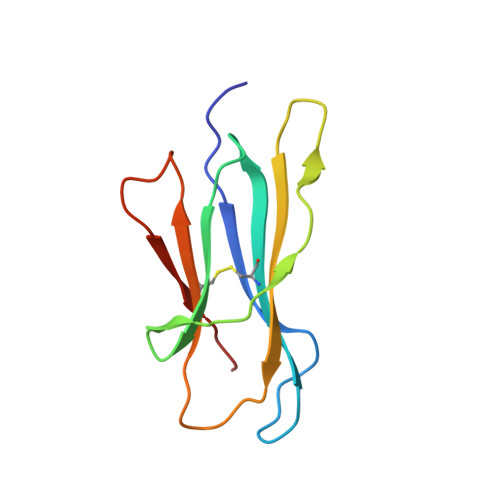A recurrent D-strand association interface is observed in beta-2 microglobulin oligomers.
Colombo, M., de Rosa, M., Bellotti, V., Ricagno, S., Bolognesi, M.(2012) FEBS J 279: 1131-1143
- PubMed: 22289140
- DOI: https://doi.org/10.1111/j.1742-4658.2012.08510.x
- Primary Citation of Related Structures:
3TLR, 3TM6 - PubMed Abstract:
β-2 microglobulin (β2m) is an amyloidogenic protein responsible for dialysis-related amyloidosis in man. In the early stages of amyloid fibril formation, β2m associates into dimers and higher oligomers, although the structural details of such aggregates are poorly understood. To characterize the protein-protein interactions supporting the formation of oligomers, three individual β2m cysteine mutants and their disulfide-linked homodimers (DIMC20, DIMC50 and DIMC60) were prepared. Amyloid propensity, oligomerization state in solution and crystallogenesis were tested for each β2m homodimer: DIMC20 and DIMC50 display a mixture of tetrameric and dimeric species in solution and also yield protein crystals and amyloid fibrils, whereas DIMC60 is dimeric in solution but does not form protein crystals nor amyloid fibrils. The X-ray structures of DIMC20 and DIMC50 show that the two engineered dimers form a tetrameric assembly; for both tetrameric species, the noncovalent association interface is based on the interaction of facing β2m D-strands and is conserved. Notably, DIMC20 and DIMC50 trigger amyloid formation in wild-type β2m in unseeded reactions. Thus, when the D-D-strand interface is impaired by an intermolecular disulfide bond (as in DIMC60), the formation of tetramers is hindered, and the protein is not amyloidogenic and does not promote amyloid aggregation of wild-type β2m. Implications for β2m oligomerization are discussed.
Organizational Affiliation:
Dipartimento di Scienze Biomolecolari e Biotecnologie and CIMAINA, Università di Milano, Italy.
















